This is the second of several guest posts that will appear here this week, all written by students who participated in this past summer’s Regional Field Geology of the Northern Rocky Mountains course.
by Cate Pearson
University of Virginia
A drive along Going-to-the-Sun Road is an amazing experience for many reasons. To any traveller, the stunning vistas and landscapes are breathtaking. To the more geologically inclined, a journey through Glacier National Park’s premier highway illustrates fundamental geologic processes in the most profound of ways.
A view along Going-to-the-Sun road. Picture taken by Andrew Evans, a National Geographic Traveller.
A formation known as the Belt Supergroup makes up most of the mountains within Glacier National Park. The Belt Supergroup actually includes a collection of formations that were the result of an ancient rifting event starting the Mesoproterozoic. This rifting event created a basin that filled and transformed into a shallow sea into which sediments were then deposited over the next 600 million years.
The extent of the Belt Supergroup in the United States and its equivalent in Canada, the Purcell Supergroup.
This process of basin creation and filling is almost textbook in its progression with a few detours here and there. One of those detours explains why Belt Supergroup sediments deposited in a rapidly subsiding basin are now weathering away at elevations over 10,000 feet. However, for the time being, let’s begin a journey that explores the extraordinary beginnings of the Belt Supergroup.
The birth of the Belt Basin
Approximately 1.6 to 1.4 Ga, a passive rifting event took place between Laurentia (think North America and specifically Montana in this case) and what would become present-day Siberia.
Passive rifting between the North American Craton (Laurentia) and the Siberian Platform. Image courtesy of the Digital Atlas of Idaho, a great resource for more information about the formation of the Belt Supergroup.
Steep basin walls and a change in base level threw what had once been a relatively stable geologic environment out of equilibrium. Erosion took over to restore balance. Sediments of various textures and provenance were transported into the young Belt Basin. Most sediments transported into the Belt Basin were sand-sized or smaller. One notable exception to this trend is the LaHood Conglomerate, a formation located at what would have been the most southeastern edge of the Belt Basin. The Lahood Conglomerate is, not surprisingly, a conglomeratic formation; angular to sub-rounded arkose clasts are supported by a matrix of fine muddy material. The immaturity of the clasts in this formation suggests a short distance of travel, minimizing the physical and chemical weathering that could have affected the rock.
The Lahood Conglomerate forms the mountain visible in the right side of the picture. The other peaks are made of various Mississippi and Permian age formations that have been faulted into contact with the mesoproterozoic LaHood Conglomerate in the Canyon of the Jefferson River.
The Lahood Conglomerate is thought to represent coarse sediments deposited by flashy streams along the eastern edge of the Belt Sea. These streams would have sporadically flowed out from the arid interior of the North American Craton to the east. The clastic, immature sediments carried by these streams may have been produced by mass wasting events such as debris flows that were subsequently carried away by short-lived floodwaters. An agreement on the exact processes responsible for carrying the sediment of the Lahood has yet to be reached, but the LaHood Conglomerate is still a significant formation within the Belt Supergroup. It marks the early stages of deposition in the Belt Basin and begins to paint the picture of what the Belt Sea and its surroundings may have been 1.4 Ga.
The Belt Sea
As rifting of North America and Siberia continued, sediments continued to pour into the Belt Basin. To the east, offshore from the area where LaHood Conglomerate sediments collected, shallow waters pooled to form the Belt Sea. In these warm waters, dolomite precipitated out to form dolostone with the occasional sandy addition. At the same time, but further to the west, the basin was deeper and sediments were laid down as a result of turbidite flows off of a deep shelf. These two concurrent facies are represented by the Altyn and Prichard Formations respectfully. Glacier National Park is located in the eastern portion of the Belt Supergroup and therefore visitors entering the park catch their first glimpse of the gleaming white dolostone of the Altyn before driving on up section to see the younger formations of the eastern Belt Supergroup.
A peaceful day on the shores of the Belt Sea?
The dolostone of the Altyn formation is consistent rather than impressive. Unlike the fascinating biology and sedimentary structures of later Belt formations, the Altyn is primarily an oolitic dolostone with the occasional inclusion of quartz sand, indicators of rough weather on the ancient coastline of the Belt Sea.
Evolution of the Belt Basin
The Belt Basin continued to fill and the shallow waters of the Belt Sea were taking shape. Above the Altyn and Prichard formations are the Ravalli Argillites, most strikingly represented by the Appekunny and Grinnell Formations within Glacier National Park. The term argillite refers to highly indurated mudstone and both the Grinnell and Appekunny share a similarly fine-grained, muddy texture. Both were also likely deposited in similar alluvial fan and tidal deposits. The primary difference between the two is color; the older Appekunny formation is distinctively sage in color, suggesting that sea level at the time of deposition was deeper and the water was anoxic. Iron in such an oxygen-poor environment would have been responsible for giving the rock its green hue. The younger, overlying Grinnell Formation is maroon in color with intermittent bands of quartz sands.The red color of the Grinnell Formation is from oxidized iron and supports the hypothesis that the waters of the Belt sea were oxygen rich and shallower during the deposition of Grinnell sediments. The quartzite beds common within the Grinnell represent beaches that would also have formed along the shallow edges of the Belt Sea. Sediments may have then been filling the basin at a rate that outpaced subsidence and been responsible for the shallowing of the Belt Sea during formation of the Grinnell Argillite.
Grinnell Formation float near an exposure in Glacier National Park. A hand lens is used for scale.
Sea level was surely dynamic during the deposition of both Appekunny and Grinnell sediments; within the Grinnell are bands of sage argillite and the Appekunny Formation has its share of stray red beds. These deviant layers are still considered to belong to the greater argillite formation in which they are found, but represent short-lived transgressions and regressions of sea level at a time when sea level was respectively either dominantly shallow or deep in the Belt Sea.
The color of the Ravalli Argillites gives a general sense of the the depth of the Belt Sea and how it was becoming increasingly shallow. However, the Grinnell and Appekunny formations also hold more clues as to the nature of the Belt Sea that are perhaps more familiar. The sedimentary structures in the Ravalli argillites are numerous and diverse, but with the key geologic principle of uniformitarianism they have been used to extract familiar environments from Mesoproterozoic rock samples. A closer look at the previous picture of Grinnell float above reveals what appear to by mud cracks. These mud cracks are formed under the same conditions as those found today in muddy areas exposed to periodic wet and dry periods. On a side note, the typical hexagonal shape of mud crack features is likely to be familiar to any geologist – take a look at the obsidian cliffs in Yellowstone for a nearby example of hexagonal patterns in geology under completely different circumstances.
A view of a fallen column from the Obsidian Cliffs. Look closely and you can see the rough hexagonal shape of the column. Field notebook for scale.
Notice any familiar patterns? (click for a larger view)
Other familiar sedimentary structures in the Ravalli Argillites include cross bedding, ripples, and scours from high energy currents. One structure in particular hints at the dynamic moments of the Belt Sea: mud chip conglomerates. These conglomerates formed during transitions from low to high energy currents. Strong currents carried quartz sand grains into a normally mud dominated environment and simultaneously ripped up clay particles. These cohesive clays formed spheres that, when energy levels returned to their normal lows, were deposited in a sandy matrix. These mud chip conglomerates are especially common in the Grinnell Formation
Ripple marks in the Grinnell Formation at Grinnell Glacier. Gloves for scale.
The Helena Formation, known as the Siyeh (sigh-ee) Formation within the Glacier National Park, is the final formation that is easily visible within the park’s boundaries. The Shepard and Snowslip Formations of the Missoula Group overlie the Helena but they are difficult to access; erosion has seen to it that there are few outcrops in the eastern portion of the Belt Supergroup left to admire.
The Helena Formation is a blue-grey limestone unit that supports the hypothesis that the Belt Sea remained shallow in the eastern edge of the Belt Basin. The key indicator of the calm nature of the Belt Sea at this time is the abundance of stromatolites, ancient algal growths, within the formation. Stromatolites were early organisms that grew in warm, clear, and shallow waters and can still be found today in such environments.
But you don’t have to travel the world to see living stromatolites to see what they look like. The thick zones of stromatolites found in the Helena Formation in Glacier National Park offer amazing views of these organisms.
Some 2013 Rockies students admiring Helena stromatolites in Glacier National park.
A stromatolite bed is visible above the field notebook being used for scale here. This exposure within the Helena Formation in Glacier National park offers an almost three-dimensional view of a stromatolites. Note the buff color of the weathered Helena limestone.
Upheaval of the Belt Supergroup
The deposition of the Belt Supergroup occurred in a massive, subsiding basin that was over ten miles thick in its deepest areas. A question that we’ll now revisit is how sediments deposited at such depths now form the mountains of Glacier National Park.
In Glacier National Park, the Mesoproterozoic rocks of the Belt Supergroup are perched unconformably over Cretaceous age rocks. A massive fault, the Lewis Overthrust, is responsible for this scrambling of the geologic record. Tectonic forces 170 Ma deformed, folded, and carried rocks of the Belt Supergroup more than thirty miles eastward along the Lewis Overthrust fault to where they are today.
Once exposed at the surface of the earth, the ancient rocks of the Belt Supergroup were vulnerable to erosion and other surface processes. One striking feature that is a result of erosion on the leading edge of the Lewis Overthrust is Chief Mountain. The Mountain is a classic example of a klippe, the German term for a cliff as well as an outlier. Chief Mountain is made of the same Mesoproterozoic rocks as the rest of the Belt Supergroup and also sits above Cretaceous age rocks. However, it looms alone over a relatively flat landscape, isolated to the east of the Belt rocks in the main Lewis Overthrust. Erosion has eaten away at the edge of the Lewis Overthrust and left remnants of the thrust sheet like Chief Mountain scattered to the east.
A cross section of the geology of Glacial National Park and the Lewis Overthrust. The Belt rocks in Glacier National Park make up the Lewis Range and Chief Mountain lies to the east of the main thrust fault.
In the more recent past, the rocks of the Belt Supergroup have been affected by glacial processes that carved the picturesque landscapes of Glacial National Park. The last ice age ended in the late Pleistocene, but the evidence of glacial activity is still obvious in the Park. Typical features of glacial geomorphology, such as U-shaped valleys, cirques, and mountain horns, can literally be spotted around each turn in the road.
A view of a typical U-shaped glacial valley see on a hike to Grinnell Glacier. Also visible is a classic sequence of paternoster lakes, glacial lakes formed as a result of moraines left by retreating glaciers.
The glaciers that remain in the park today are shadows of the glaciers of the last ice age and even the glaciers of a century ago; even the iconic Grinnell Glacier has seen dramatic retreats in just the last fifty years. However, the rocks of the Park will likely inspire visiting geologists for years to come and the glaciers are still certainly worth the hike as well…
Hiking across an ice flow near Grinnell Glacier. Can you spot the person for scale?

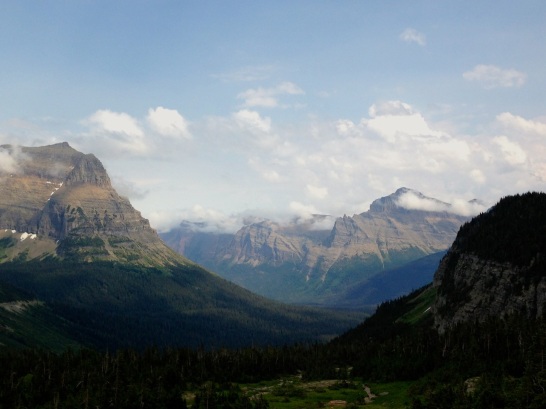
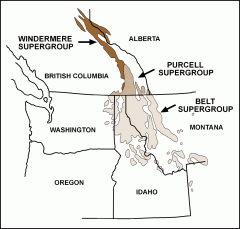
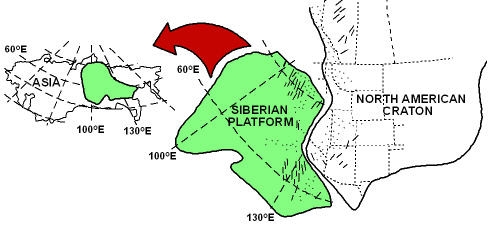
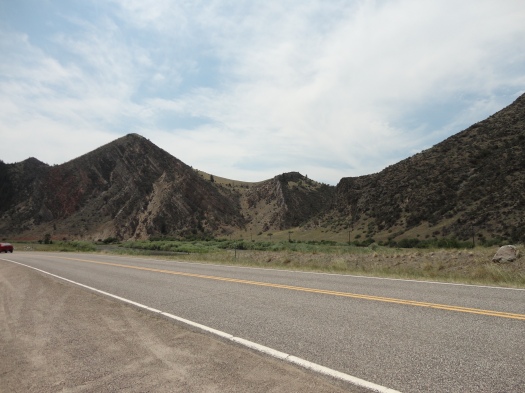
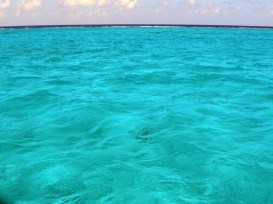
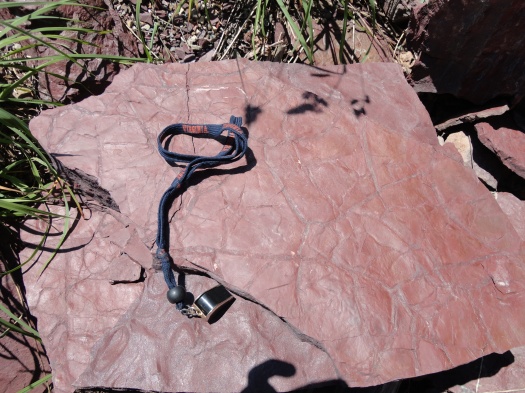
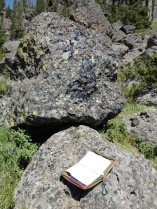
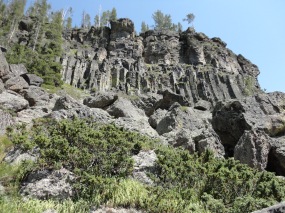
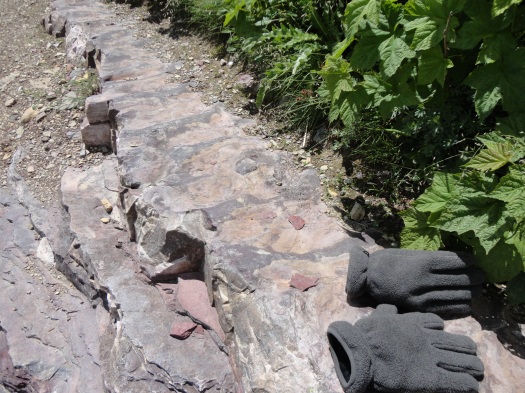


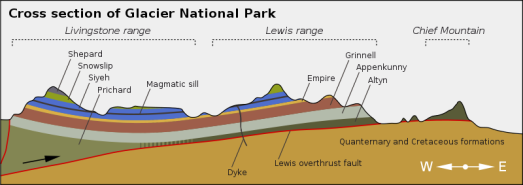
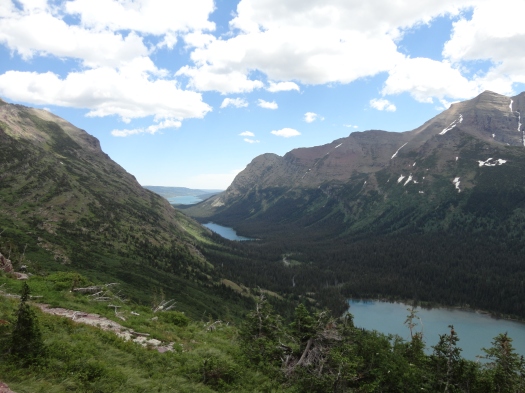
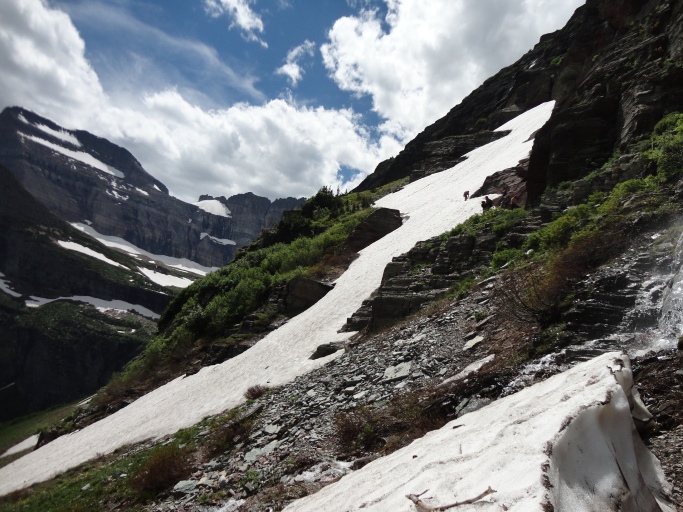
Nice job of explaining the creation of the Belt Sea and its sedimentary process. Is it known at what latitudes that the Belt Sea was created? And what was the sequence of transgression and regression that the various formations were deposited?
Great questions!
…I don’t know the answers. Overall, the sequence of strata at Glacier NP (which showcase but one group within the supergroup) shows a shallowing sequence (regression?) from the base toward the middle (Altyn –> Apekunny –> Grinnell). Beyond that observation, you’re on your own…
Marvelously informative post. Thank you.
While skiing in the park I have wondered how closely the upper layers of Glacier track with the upper layers of Yoho and Banff, i.e., the Continental Divide here with the Continental Divide a couple hundred miles north. Specifically, does the Cathedral Escarpment of Burgess Shale fame have an equivalent in Glacier? The next obvious question, of course, would be whether or not Cambrian fossils have been found in Glacier…
Apparently [http://www.nps.gov/glac/naturescience/fossils.htm], the answer about Cambrian fossils is “no”–because of the Lewis Overthrust. So, would it be correct to conclude that the geological processes at Glacier (i.e., the existence of an overthrust) were fundamentally different from those further up the Continental Divide at Yoho?
Given the similarity in appearance–both mountain shapes and the colors of the high-altitude bands, that seems to me a curious conclusion. Did I get confused?
Hello –
Totally different layers, in both lithology (rock type) and age. The commonality is that both were sculpted by glaciers, so they have roughly the same shapes.